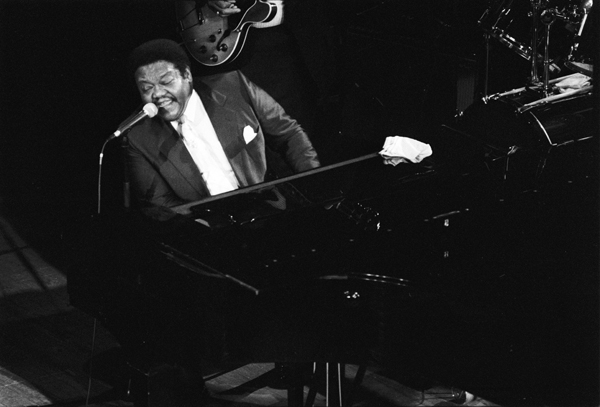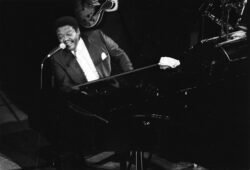Rhythm and Blues Music
The rhythm and blues (R&B) music heritage in Louisiana includes a wide variety of styles, beginning in the 1940s and continuing until today.

Courtesy of Wikimedia Commons
Fats Domino Performing in Normandy, France, in 1992. Godefroy, Roland (Photographer)
The rhythm and blues (R&B) heritage in Louisiana includes a wide variety of styles of national significance, beginning in the 1940s and continuing until today. From 1947 to 1971, more than 260 Louisiana-based or Louisiana-related rhythm and blues recordings appeared on Billboard magazine’s Top 100 sales charts. From 1957 to 1961, in particular, a period when R&B exercised its greatest influence on mainstream rock ‘n’ roll, Louisiana R&B singles accounted for 125 Billboard Top 100 hits—an average of roughly 25 hits per year. The greatest number of those were recorded by New Orleans R&B singer and pianist Antoine “Fats” Domino, an icon of post-World War II American popular music.
While New Orleans was easily the state’s most prominent source for R&B activity, other regions also made uniquely local contributions. The southwestern parishes saw local music influenced by the R&B sound gradually evolve into two distinct genres: swamp pop, a version of what came to be called “blue-eyed” soul, and zydeco, created from a distinct blend of Cajun, Creole, and R&B elements. In addition, Louisiana-based musicians and producers influenced national R&B artists.
The New Orleans musical environment, in particular, could also be powerfully transformative. Ray Charles frequented the city for two years in the early 1950s, arriving as an easygoing blues crooner and leaving as the innovator of a new style of gospel-influenced, powerfully emotional R&B that would later be called soul music. In the mid-1950s, a Georgia native named Richard Penniman recorded in New Orleans, scoring a string of hits as the high-spirited and wildly exuberant vocalist Little Richard. And another central R&B figure, Sam Cooke, recorded briefly in New Orleans and relied on New Orleans-trained musicians for some of his best-known national hits.
Pioneering Sounds
New Orleans produced a substantially large, if often overlooked, proportion of the musicians responsible for forging the early sounds of R&B and rock-and-roll. In 1947, for example, Annie Laurie, singing with the Paul Gayten Orchestra, made a hit with “Since I Fell for You,” later a frequently recorded R&B ballad. In 1948, Roy Brown had a national dance hit with “Good Rockin’ Tonight,” often cited as one of the earliest rock ‘n’ roll songs. Vocalist Lloyd Price, whose string of 1950s rock ‘n’ roll hits would include “Stagger Lee” and “Personality,” first achieved national notice with “Lawdy Miss Clawdy” in 1952. The city’s greatest musical strength, however, was its piano players—especially those schooled in a rhythmic, blues-derived style called boogie-woogie. Within just a six-month period during the early 1950s, three New Orleans piano players released nationally successful records: Fats Domino (“The Fat Man”), Leon T. Gross, known as Archibald, (“Stack-A-Lee”), and Henry Roeland Byrd, later known as Professor Longhair (“Bald Head”).
Saxophonist and bandleader Louis Jordan, widely considered an essential figure in the transition from jazz to R&B, implicitly acknowledged New Orleans’s central role in helping create an atmosphere ripe for the development of rock ‘n’ roll in his 1949 hit “Saturday Night Fish Fry.” Remaining number one on R&B sales charts for twelve weeks, the song is set on Rampart Street in New Orleans, with two musicians attending a raucous occasion where the participants were “scufflin’ and shufflin’ ‘til the break of dawn.” Indeed, New Orleans has a long history of both social events and of music that reflects those events. But New Orleans’s musical influence in the transition from R&B to rock ‘n’ roll depended more heavily on two other factors. These were the preponderance of talented musicians living in the city—the result of a musical heritage dating back at least to the earliest days of jazz—and the 1947 establishment of J&M Recording, a studio founded by producer Cosimo Matassa.
Working closely with songwriter and arranger Dave Bartholomew, Matassa created an atmosphere in which talented local musicians felt free to collaborate in the recording process. The resulting hit records made in New Orleans, especially those by Fats Domino, attracted independent record companies with more direct access to national markets, including Atlantic Records (New York City), Imperial Records and Specialty Records (Los Angeles), and Chess Records (Chicago).
Spreading the Louisiana Influence
In retrospect, the partnership of Matassa and Bartholomew, combined with a steady supply of talented local musicians, created a template for future regional record labels. According to one account, “Along with Sam Philips’s Sun Studio in Memphis, J&M was to become one of the two most productive studios in early rock and roll.” Sun Records is where artists like Elvis Presley, Carl Perkins, Johnny Cash, and Roy Orbison first achieved national prominence during the mid-1950s. In fact, J&M Studios preceded Sun Records by several years and drew on a rich supply of talent in all phases of the recording process. In that regard, J&M Studios can also be seen as a precursor to influential labels like Stax Records in Memphis and Motown Records in Detroit, Michigan, as well independent labels in the world of hip hop.
Another measure of New Orleans’s influence is the large number of songs recorded originally by New Orleans musicians that became national hits for more prominent artists, including “Ain’t That a Shame” (Pat Boone), “Dizzy Miss Lizzy” (The Beatles), “Time Is on My Side” (The Rolling Stones), “Let the Good Times Roll” (Jimi Hendrix), and “Southern Nights” (Glen Campbell), among many others.
The “British Invasion” of the early 1960s sidelined many R&B and rock ‘n’ roll musicians. One of the most telling stories in this regard is that of New Orleans vocalist Irma Thomas, poised on the edge of national stardom during her early twenties. Soon after The Rolling Stones recorded her regional hit “Time Is on My Side”—complete with her distinctive, spoken interlude—the mother of four found herself working behind a dry-goods chain store sales counter. Although Louisiana in general and New Orleans in particular never regained the widespread popular influence it enjoyed during the 1950s and early 1960s, the state’s R&B traditions remained very much alive.
Revivals, Brass Bands, and Hip Hop
In the state’s southwestern region, “swamp pop” music by white musicians immersed in R&B traditions like The Boogie Kings, remains locally popular. Pioneered in the 1950s by Clifton Chenier, zydeco remains vital today. In New Orleans, pianist and songwriter Allen Toussaint emerged in the mid-1970s as a much sought-after producer. His core group of studio musicians, The Meters, helped to advance the rhythmically muscular descendent of R&B known as funk. They became precursors to The Neville Brothers. Beginning with their 1976 landmark album, Wild Tchoupitoulas, the four Neville brothers achieved international success by joining forces and celebrating the legacy of New Orleans R&B for audiences all around the world.
Also in the 1970s, the New Orleans Jazz & Heritage Festival, an annual celebration of Gulf Coast cultures, began to receive national attention, setting the stage for a revival of veteran New Orleans R&B figures, including Professor Longhair, Irma Thomas, and many more. Concurrently, the city generated a new wave of small, neighborhood brass bands, beginning with The Dirty Dozen Brass Band and the aptly named Rebirth Brass Band, mixing traditional and modern jazz with elements of R&B and funk.
